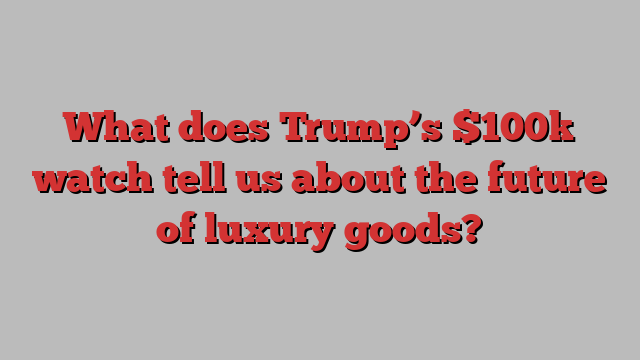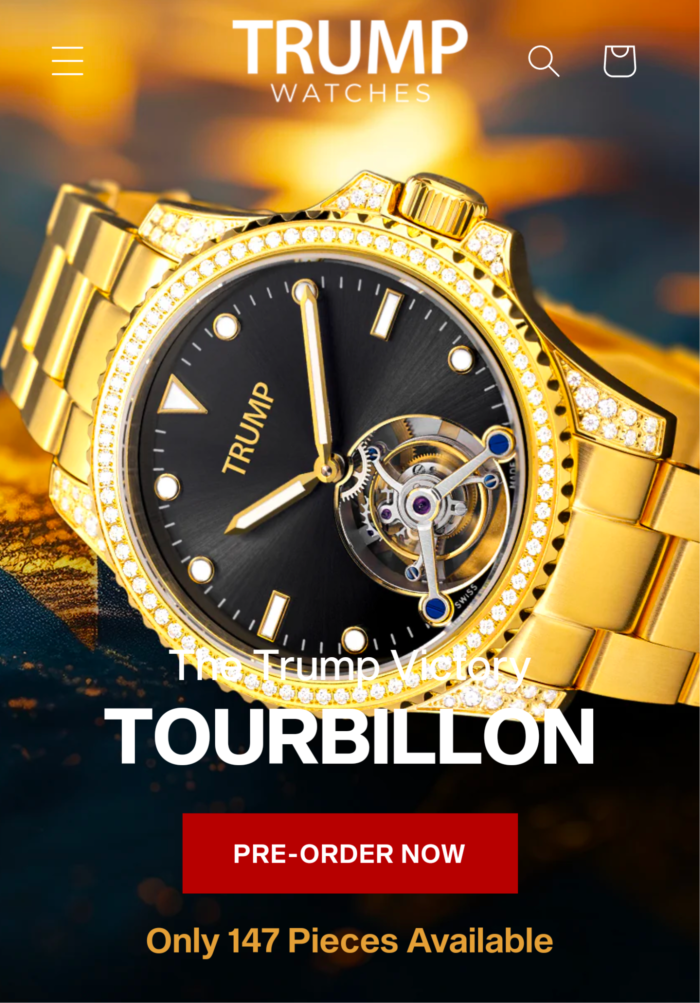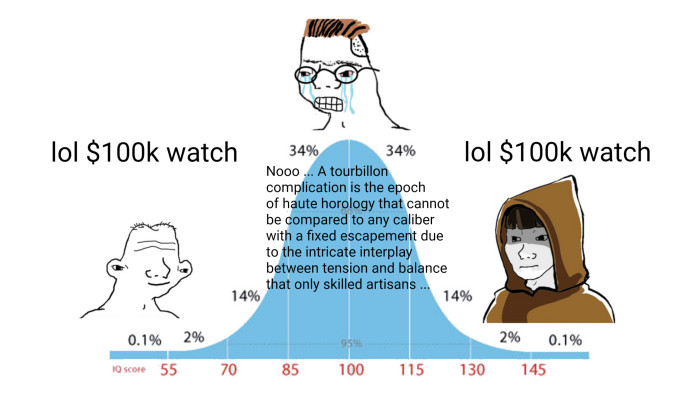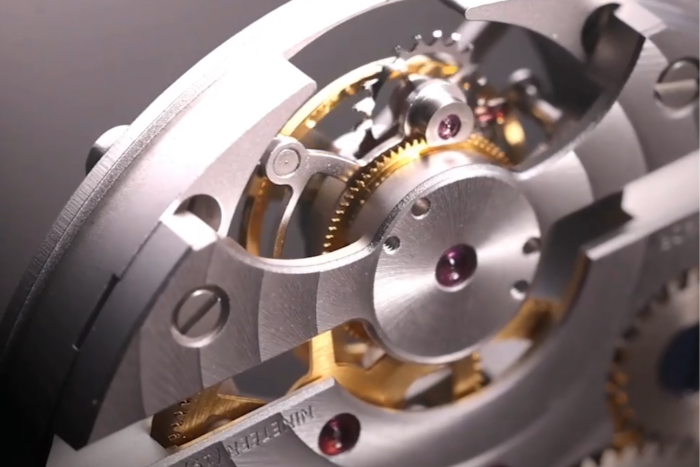
We write about watches on our finance blog for several reasons. The first is that watches measure consumer confidence. Hardly anyone needs a watch, and the few that do would be best with a Casio F91w, so there’s a lot to read into regional changes in demand for more tricksy and showy stuff.
The second is that Swatch and Richemont are listed, as is Watches of Switzerland, so it’s markets-adjacent content. Third, the privately owned watchmakers expect us to reproduce their hoopla while respecting their secrecy around business practices and frankly, we’d rather not. Fourth, our readers click a lot on stories about watches.
That’s why, when a new horological microbrand appears, we take notice. For example:

The Victory Tourbillon is the limited edition flagship of a range of watches sold by Trump, a multi-faceted leisure and lifestyle brand. The ticket price is $100,000, which made FTAV wonder about the mark-ups.
Tourbillon means there’s a rotating cage around a tick-tock bit. The idea is to make the watch mechanism more accurate by minimising the effects of gravity and, though it probably does nothing, people appreciate the extra engineering required.
Tourbillons have become a lot less special in recent years though, with Chinese factories churning out decent reproductions and simulacra of Swiss workmanship, and the Swatch-owned ETA movement maker able to supply the most fiddly bits in kit form. Only a few makers design their own movements from scratch and, at the super high-end, the arms race has moved to making everything as thin as possible.
Or, to put it as an old meme:

The Trump Victory Tourbillon isn’t particularly thin, but it does say “Swiss Made” on the dial, so it can’t be using a Chinese-made movement. (There are a lot of rules governing adverts of Swiss origin, including that a watch movement has to be assembled in Switzerland.) ETA only really makes movements for Swatch brands these days, which narrows things down further.
The website says:
The Trump Victory Tourbillon comes equipped with a Swiss-made TX07 Tourbillon. Each watch is composed of over 200 individual parts, all working in perfect harmony for outstanding performance.
. . . which means nothing. However, the page also includes a video of a movement in close-up with a distinctive symmetrical plate over the balance wheel:

That’s one tell-tale sign of a BCP T02. Designed by Olivier Mory, the T02 is a movement sold to small-batch watchmakers including Yema, Aventi and Louis Erard. Time & Tide says Mory discovered “the cheat code” for making Swiss tourbillons affordable.
Mory confirmed by email that he was supplying the Trump Victory Tourbillon movement to a third-party watch assembly company, adding:
We use the standard price list of our Tourbillon range which is around 4700 USD / movement for batches in the 100-200 size. We are usually very competitive in this batch size for a movement which is 100% Swiss Made.
(Mory also sent us a schematic of the movement that list suppliers for every cog, spring and pin. The information doesn’t add anything to this post, but in an industry addicted to secrecy and bullshit, such transparency is like a breath of fresh air.)
So anyway, we’re off. Movement: $4,700.
Another Swiss watchmaker that avoids woo-woo is Code41, which is sort-of a horological BrewDog. Members of its online community vote on designs and get detailed spec sheets for each build, including for the tourbillon it developed in 2022/23 in partnership with Olivier Mory’s BCP Tourbillon.
Code41 has a fair bit of detail on its website that breaks down the wholesale cost of watch parts. Quality and intricacy move the dial a lot but for a basic build, watch faces start at about $10 and cases can be as cheap as $25. Better quality might mean $50 for the face and $80 for the body, Code41 says.
Watch retail prices are typically six to eight times the assembly price, but Code41 only sells direct so says it applies a mark-up of 3.5 times cost. Its tourbillons sell for about £12,500 ($16,700), implying a wholesale unit price of about $4,800. It’s therefore reasonable to assume that, even for something aiming at the high end, the cost of bits other than the movement probably doesn’t add up to more than $200.
This won’t be true of the Trump Victory Tourbillon, which according to the website features “approximately 200 grammes” of 18 carat gold “across the band, case and buckle,” and is “decorated with 122 VS1 diamonds”. All we need to cost up is the acrylic backplate, the face and some fixings. We’ve gone cautious and added $200 for these items but judging by the photos that’s highly likely to be an overestimation.
Nevertheless, two-hundred grammes of gold is a lot of gold. It’s approximately the weight of a hamster, which puts the Trump Victory Tourbillon on the same weight category as big units like the Rolex Deepsea, which in gold has a US list price of $52,100.
Gold spot is $2648 an ounce at pixel time so 200 grammes of 18 carat is approximately $19,000 of gold.
Then there are the diamonds. VS1 means a diamond that’s slightly imperfect. It’s five notches below flawless, so if diamonds were rated like bonds it’d be approximately a BBB+.
But there’s not much in the way of information at this end of the diamond market. Certifying the quality of any stone that weighs less than a quarter of a carat (meaning about 4mm in diameter) is a waste of money. The stones encrusting the Trump Victory look to be 2mm at most, so even with the VS1 clarity rating, any estimate of value has to be a guess.
A single pinhead-sized diamond might retail at $15 (or a fraction of that when lab grown). Again, we’ll go cautious. It’s not unreasonable to think that 122 pinhead VS1-clarity stones would cost approximately $2000, though it might be much less.
Here are the scores so far.
Movement: $4,800
Gold: $19,000
Diamonds: $2,000
Face, fittings, etc: $200
Square the cost off to $25,000 to take into account of purchase timings, assembly, third-party bulk discounts etc and we’re probably in the right sort of ballpark. As Dolly Parton said, it takes a lot of money to look this cheap.
The big thing in Swiss watchmaking at the moment is hyper-premiumisation. The bottom fell out of the watch resale market last year, causing some pain among speculators and meaning waiting lists are much less of a thing, but the big brands have been able to counter lower volumes with higher average selling prices.
Swiss watch exports data for August showed precious metal sales by value up 21 per cent and steel watch sales down 10 per cent. Watches priced at more than SFr3,000 wholesale ($3500) were the only category growing, thanks probably to gold and platinum watches that cost on average 25 times more than their steel equivalents.
That still only means about 30,000 precious-metal Swiss watches sold per month though, with most of those sales happening in Asia or to Asian consumers. Morgan Stanley estimates that bling only makes up 2.6 per cent of the market by volume.
The top tier of Swiss watches (meaning Rolex, followed not particularly closely by Vacheron Constantin, Patek Philippe, Audemars Piguet and Richard Mille) accounts for three-quarters of the Switch exports by value. That’s the market the Trump Victory Tourbillon is competing in.
And the profit pool is even more unevenly distributed than those figures suggest. Privately owned Rolex, Patek and AP are raking it in, with estimated operating margins of about 40 per cent. But publicly owned watchmakers report operating margins of about 20 per cent for their watch divisions, which in part reflects portfolios that include halo brands. Richemont-owned Lange & Söhne probably can’t turn a profit, for example, in spite of routinely costing $50k+ per unit.
Morgan Stanley estimates that below the big sellers like Omega (Swatch) and Cartier (Richemont), “a large number of other brands in the listed groups’ portfolios were not covering their cost of capital.”
But of course, the Trump Victory Tourbillon is a built-to-order watch that’s being sold direct to consumers from one website that has a marketing budget of zero, because articles like this are all the publicity it needs.
There are very few operational costs to add to the $25,000 materials cost, so the operating margin is probably not much worse the ~75 per cent gross margin. If Trump sells all 147 Tourbillons that’s an estimated $11mm operating profit. That’s decent.
Nor are 75 per cent margins exceptional. Morgan Stanley estimates that Moonswatch, Swatch’s co-branded fashion disposable range that has sold more than 3mn units in the past two years, has a gross margin of about 80 per cent.
The difference is that Trump’s watch is in a market segment that’s dominated by a big five plus several hundred loss-leaders and vanity projects. These manufacturers have big fixed costs, as they are mostly vertically integrated, and run very high inventory levels. They are increasingly exposed to a very small segment of an Asia-reliant market that’s highly sensitive to FX, policy stimulus and capital controls. This makes them more fragile to any sustained downturn, in which operational degearing will be brutal.
Does that make Trump’s asset-light, demographically targeted approach to hyper-premiumisation a potential way forward for the Swiss watch industry and the wider luxury goods sector? No. Of course not.
Further reading:
— Is that the sound of a luxe watch bubble popping? (FTAV)
— What the Watches of Switzerland warning says about Rolex demand (FTAV)
— Watches have stopped (FTAV)